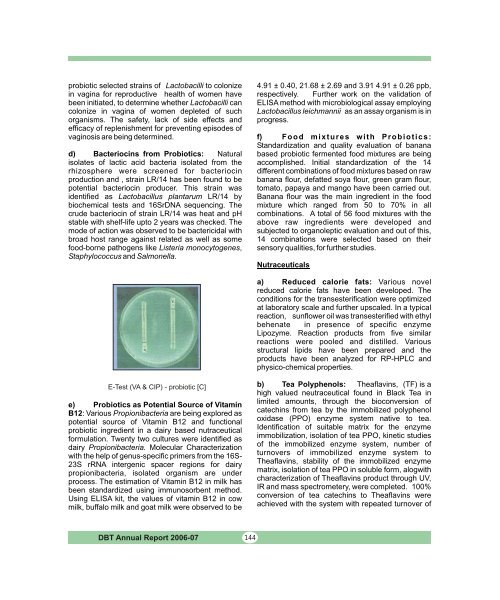ANNUAL REPORT - Department of Biotechnology
ANNUAL REPORT - Department of Biotechnology
ANNUAL REPORT - Department of Biotechnology
Create successful ePaper yourself
Turn your PDF publications into a flip-book with our unique Google optimized e-Paper software.
probiotic selected strains <strong>of</strong> Lactobacilli to colonize<br />
in vagina for reproductive health <strong>of</strong> women have<br />
been initiated, to determine whether Lactobacilli can<br />
colonize in vagina <strong>of</strong> women depleted <strong>of</strong> such<br />
organisms. The safety, lack <strong>of</strong> side effects and<br />
efficacy <strong>of</strong> replenishment for preventing episodes <strong>of</strong><br />
vaginosis are being determined.<br />
d) Bacteriocins from Probiotics: Natural<br />
isolates <strong>of</strong> lactic acid bacteria isolated from the<br />
rhizosphere were screened for bacteriocin<br />
production and , strain LR/14 has been found to be<br />
potential bacteriocin producer. This strain was<br />
identified as Lactobacillus plantarum LR/14 by<br />
biochemical tests and 16SrDNA sequencing. The<br />
crude bacteriocin <strong>of</strong> strain LR/14 was heat and pH<br />
stable with shelf-life upto 2 years was checked. The<br />
mode <strong>of</strong> action was observed to be bactericidal with<br />
broad host range against related as well as some<br />
food-borne pathogens like Listeria monocytogenes,<br />
Staphylococcus and Salmonella.<br />
E-Test (VA & CIP) - probiotic [C]<br />
e) Probiotics as Potential Source <strong>of</strong> Vitamin<br />
B12: Various Propionibacteria are being explored as<br />
potential source <strong>of</strong> Vitamin B12 and functional<br />
probiotic ingredient in a dairy based nutraceutical<br />
formulation. Twenty two cultures were identified as<br />
dairy Propionibacteria. Molecular Characterization<br />
with the help <strong>of</strong> genus-specific primers from the 16S-<br />
23S rRNA intergenic spacer regions for dairy<br />
propionibacteria, isolated organism are under<br />
process. The estimation <strong>of</strong> Vitamin B12 in milk has<br />
been standardized using immunosorbent method.<br />
Using ELISA kit, the values <strong>of</strong> vitamin B12 in cow<br />
milk, buffalo milk and goat milk were observed to be<br />
DBT Annual Report 2006-07<br />
144<br />
4.91 ± 0.40, 21.68 ± 2.69 and 3.91 4.91 ± 0.26 ppb,<br />
respectively. Further work on the validation <strong>of</strong><br />
ELISA method with microbiological assay employing<br />
Lactobacillus leichmannii as an assay organism is in<br />
progress.<br />
f) Food mixtures with Probiotics:<br />
Standardization and quality evaluation <strong>of</strong> banana<br />
based probiotic fermented food mixtures are being<br />
accomplished. Initial standardization <strong>of</strong> the 14<br />
different combinations <strong>of</strong> food mixtures based on raw<br />
banana flour, defatted soya flour, green gram flour,<br />
tomato, papaya and mango have been carried out.<br />
Banana flour was the main ingredient in the food<br />
mixture which ranged from 50 to 70% in all<br />
combinations. A total <strong>of</strong> 56 food mixtures with the<br />
above raw ingredients were developed and<br />
subjected to organoleptic evaluation and out <strong>of</strong> this,<br />
14 combinations were selected based on their<br />
sensory qualities, for further studies.<br />
Nutraceuticals<br />
a) Reduced calorie fats: Various novel<br />
reduced calorie fats have been developed. The<br />
conditions for the transesterification were optimized<br />
at laboratory scale and further upscaled. In a typical<br />
reaction, sunflower oil was transesterified with ethyl<br />
behenate in presence <strong>of</strong> specific enzyme<br />
Lipozyme. Reaction products from five similar<br />
reactions were pooled and distilled. Various<br />
structural lipids have been prepared and the<br />
products have been analyzed for RP-HPLC and<br />
physico-chemical properties.<br />
b) Tea Polyphenols: Theaflavins, (TF) is a<br />
high valued neutraceutical found in Black Tea in<br />
limited amounts, through the bioconversion <strong>of</strong><br />
catechins from tea by the immobilized polyphenol<br />
oxidase (PPO) enzyme system native to tea.<br />
Identification <strong>of</strong> suitable matrix for the enzyme<br />
immobilization, isolation <strong>of</strong> tea PPO, kinetic studies<br />
<strong>of</strong> the immobilized enzyme system, number <strong>of</strong><br />
turnovers <strong>of</strong> immobilized enzyme system to<br />
Theaflavins, stability <strong>of</strong> the immobilized enzyme<br />
matrix, isolation <strong>of</strong> tea PPO in soluble form, alogwith<br />
characterization <strong>of</strong> Theaflavins product through UV,<br />
IR and mass spectrometery, were completed. 100%<br />
conversion <strong>of</strong> tea catechins to Theaflavins were<br />
achieved with the system with repeated turnover <strong>of</strong>

















